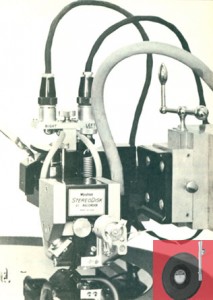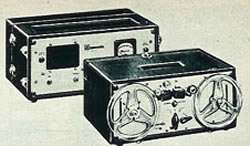The advent of tape recorders in recording studios led to innovations in recording that radically altered the making of music. Most radio and record studios in the U.S. adopted Ampex recorders (although there were competitors from RCA, Presto, and others) for making master recordings.

A cutting head for recording stereo disks.

Portable Magnecorder
The less-expensive Magnecorders were popular in radio stations and studios where these workhorse machines were used for heavy production and editing work. The basic techniques of editing – cutting and splicing to remove, re-arrange, or compile pieces of recordings, mixing two or more sound sources into one recording, and fading sound in or out-were all innovations that were made easier with tape. Where in the past performers had to execute songs perfectly (or with minimal errors), or else face remaking the whole recording, now it was sometimes possible to splice together two or more flawed recordings to make a perfect one. Engineers and artists found that it was also easier to manipulate sounds on tape, leading to the use of all sorts of special effects, such as using a recorder to allow a single artist appear to accompany her/himself.
Even in the late 1940s, there were experiments with multitrack recording on tape. Multiple simultaneous soundtracks had been possible, though expensive, since the 1930s on motion picture film. As engineers reduced the size of tape recorder heads, it became possible to mount two or three heads on a single recorder, equip each with a recording/reproducing amplifier, and record multiple simultaneous tracks on a single tape. This feature was used in two ways. In the studio, groups of musicians or singers could be separated into two or three groups, such as recording the rhythm section and the rest of the band separately. If there was a flub on one or the other tracks, it could be re-recorded without re-assembling the whole band. After years of perfecting this technique, it became the basis of increasingly complex recordings in the 1960s. More and more tracks were added to recorders to allow 24 or more tracks to be recorded on a single, very wide tape.